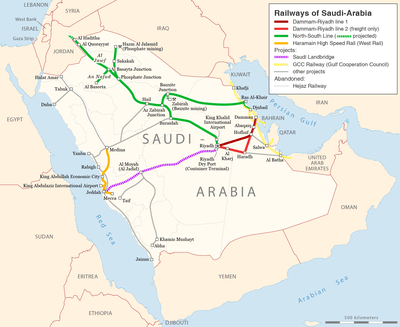SAR North–South Railway line
The North–South Railway line is a 2,750 kilometres (1,709 mi) railway line built by Saudi Railway Company (SAR) in Saudi Arabia. Operation on 1,392 kilometres (865 mi) long freight part of the project connecting Al-Haditha and Jalamid with new port city Ras Al-Khair was started in Jan 2015.[2] An 85 km link is planned which would connect the North–South railway with the port at Jubail.[3]
| SAR North South Railway line | |||
|---|---|---|---|
 | |||
| Overview | |||
| Type | freight | ||
| Status | operational | ||
| Locale | Al Jawf Region, Northern Borders Region, Ha'il Region, Al-Qassim Region, Riyadh Region and Eastern Province, Saudi Arabia | ||
| Termini | Al-Haditha Riyadh | ||
| Stations | 9 | ||
| Services | Riyadh, Sudair, Qassim, Hail, Ras Al-Khair, Jubail, Al-Jawf, Al-Basaita, and Al-Haditha. | ||
| Website | http://www.sar.com.sa/ | ||
| Operation | |||
| Owner | Saudi Railway Company (SAR) | ||
| Operator(s) | Saudi Railway Company (SAR) | ||
| Rolling stock | 25 EMD SD70ACS Locomotives [1] | ||
| Technical | |||
| Line length | 2,750 kilometres (1,708.8 mi) | ||
| Track length | 2,750 kilometres (1,708.8 mi) | ||
| Track gauge | 1,435 mm (4 ft 8 1⁄2 in) standard gauge | ||
| Operating speed | up to 100 km/h | ||
| |||
The line starts from Al-Jalamid mine which is located in the northeast in the Northern Territory, through Al-Jawf and Hail until arriving at the "AlBaithah railway junction" in the Qassim region. It then headed toward the southeast for processing and export facilities at Ras Al-Khair in the Eastern Province near Jubail. The line shares infrastructure with the SAR Riyadh-Qurayyat Line between Buraidah and Al Nafud. The line is a dedicated freight corridor, however, the SAR Riyadh-Qurayyat Line operates only passenger services.[4]
The first six of 25 EMD SD70ACS freight locomotives ordered in April 2009 were handed over to SAR at Port Dammam on 22 August 2010.[5]
Passenger diesel push–pull trains made by Construcciones y Auxiliar de Ferrocarriles arrived in April 2015, and are designed to run at 200 km/h up to 55 degrees C.[6] Each of the SAR trains includes a restaurant car, family zone and a prayer compartment, as well as both seating and sleeping cars. They are expected to run in formations of nine and 13 cars.[6]
See also
- Saudi Railways Organization (SRO)
- Saudi Railway Company (SAR)
- Transport in Saudi Arabia
References
- Electro-Motive Diesel, Inc. is Awarded New Locomotive Contract for 25 SD70ACS Locomotives from Saudi Railway Company (SAR)
- "World rail infrastructure market September 2012 - Railway Gazette". Railway Gazette International. Retrieved 24 September 2012.
- Saudi Railway Company seeks operating concessionaire
- Desert locomotives delivered to Saudi Arabia
- http://www.railwaygazette.com/news/passenger/single-view/view/sars-first-passenger-train-arrives.html
